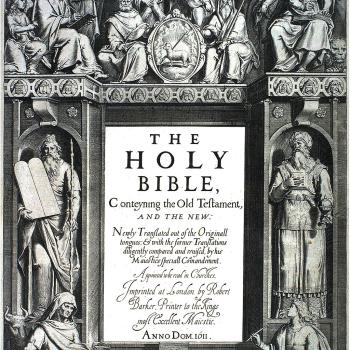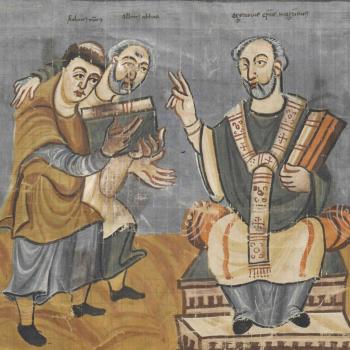I recently blogged on the many and various ways in which translators subtly (and usually unconsciously) change the meaning of a text by capitalization and punctuation. Here is an illustration that seems quite powerful to me.
Around 170 BC, the former high priest Onias III was murdered as a result of intrigues within the Jerusalem priestly elite, working with officials of the Seleucid Empire. The whole ugly story is told in 2 Maccabees 4. But the affair had a long and weighty afterlife, which proved amazingly and influentially Christological. Around 165 BC, the author of Daniel (9.25-26) included a pseudo-prophecy about events running up to the time of writing, placed in the words of the angel Gabriel. He included here the murder of Onias, who was both a princely aristocrat and also an anointed high priest. The word translated “anointed” is the same as our “messiah.” By the time we get into Greek translations of Daniel’s Hebrew, Onias is christou hegoumenon, roughly “the anointed, the prince,” or the “anointed prince.”
At a very early stage, some Jewish readers read this passage as a prophecy of a great leader who was still to come, whether that might be Herod the Great, or even (as Josephus himself held) the Emperor Vespasian. As Christians reinterpreted the passage, they were naturally struck by this christos figure, who died violently. In the Latin Vulgate, we read about the killing of the Messiah (occidetur Christus). Note that normal printings of that Latin text today capitalize Christus, so the obvious reading suggests a link to Jesus Christ. The original text includes no such necessary suggestion.
Here are some English versions – and in each case, note not just the translation, but the capitalization. See how that usage transforms an “anointed” into “Messiah” or “Christ.”
Here is the King James version:
Know therefore and understand, that from the going forth of the commandment to restore and to build Jerusalem unto the Messiah the Prince shall be seven weeks, and threescore and two weeks: the street shall be built again, and the wall, even in troublous times. And after threescore and two weeks shall Messiah be cut off, but not for himself.
Here is the RSV, the most restrained in its Christological implications:
Know therefore and understand that from the going forth of the word to restore and build Jerusalem to the coming of an anointed one, a prince, there shall be seven weeks. Then for sixty-two weeks it shall be built again with squares and moat, but in a troubled time. And after the sixty-two weeks, an anointed one shall be cut off, and shall have nothing.
And the NIV:
“Know and understand this: From the time the word goes out to restore and rebuild Jerusalem until the Anointed One, the ruler, comes, there will be seven ‘sevens,’ and sixty-two ‘sevens.’ It will be rebuilt with streets and a trench, but in times of trouble. After the sixty-two ‘sevens,’ the Anointed One will be put to death and will have nothing.
Note the decision to capitalize “Anointed One.” Also, quite apart from capitalization, note how the NIV speaks of “the” anointed one, not “an” anointed one, as in the RSV. A major difference.
You can look through the many other variants (in multiple languages) by going to the invaluable biblegateway.com.
That “Seventy Week Prophecy” has attracted much interest through the centuries, and is a matter of special concern in the Adventist tradition. Mormons also value the passage highly. As I’ve suggested, I don’t believe it is a messianic prophecy, but it’s fascinating to see how various Bible versions shape it more or less to that purpose – and often by quite subtle adaptations.
Finally, can I ask one favor? You may feel impelled to protest that I am treating this Daniel passage as pseudo-prophecy written after the event, and to assert that the prophetic materials here are genuine. Before writing, could you please read my earlier blog on this topic? Thanks.
















